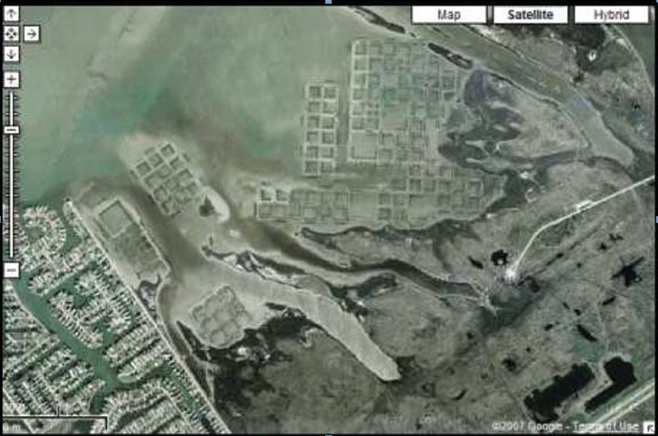It is possible to create new wetlands in areas where the water has become too deep to sustain wetland vegetation. The science and practice behind estuarine marsh creation has made great strides within the past two decades. While it is not yet possible to suggest that equally productive replicas of natural wetlands can be created, we are getting much closer and we have a much better understanding of how to create such wetlands.
A Texas Sized Example

Figure 9: Galveston Island State Park, TX. Reticulated grid pattern in upper center of photograph is a complex of wetlans restored to a previously subsided area through the placement of fill material and transplanting of vegetation. The grid provides for maximum edge, the single most important factor in ecological success of constructed tidal wetlands. Google Maps image captured January 2007.
Texas lost at least 59,000 acres of fringing estuarine wetlands between the 1950s and the early 1990s due to subsidence associated with industrial and municipal groundwater removal (Moulton et al., 1997). Thirty five thousand acres of that loss occurred in Galveston Bay, approximately 20 percent of the estuarine marshes there. (White et al 1993). Few of these wetlands were naturally replaced, both because of the rapidity of the change and because of the coastal topography, inundation proceeded up to the steep slope but did not rise above it.
In response to this massive and rapid loss of wetlands, considerable local, state, and federal resources have been mobilized to restore these wetlands, primarily through the placement of fill and the planting of wetland vegetation. Dredging of the Houston Ship Channel and other waterways provided and continues to provide an abundant and steady source of fill material. A Beneficial Uses Group (the “BUG” group), for example, was formed to marshal resources to build as many new wetlands as possible using dredge-spoil material. Many other groups and agencies are also involved in wetland restoration projects that involve some combination of elevation and plant transfer. Marsh Mania is an annual event involving several entities and sites that draws hundreds of volunteers for marsh plantings.
In spite of these impressive accomplishments, only about 1,500 acres of marsh were created between the mid-1970’s and 2002, according to the Galveston Bay Estuary Program’s State of the Bay (Lester and Gonzalez, 2002), or less than 5 percent of the loss. No data was provided as to the success of these projects, but there is little doubt of the success of the more recent projects from about the last decade.
Wetland Creation: Pros and Cons
These creation and restoration projects involve very careful control of the bottom elevation for the new marshes. Fill material is placed to an elevation that guarantees success for current conditions. To our knowledge, few restoration projects are designed with future sea level rise in mind. Most of the wetlands constructed to date will be lost to sea level rise even under the most conservative scenarios. But these wetlands are today performing essential functions, and from a policy adaptation viewpoint, what is learned today from wetland construction projects will be useful in the future to help build replacement wetlands.
Given the expense and difficulty of building new wetlands, it is not certain that wetland creation through elevation could be a major adaptation to rising sea levels. Certainly, it could be an important tool for replacing specific wetland functions in certain high value, critical areas, but it is difficult to know if wetland construction could have widespread impact. Depending on the rate of sea level rise, these creation projects, as currently designed, would have to be redone every decade or so. It would not be all that difficult to engineer constructed wetlands projects in the estuarine zone to allow for some degree of sea level rise: berms or marsh mounds that are a little wider and taller, for example.



